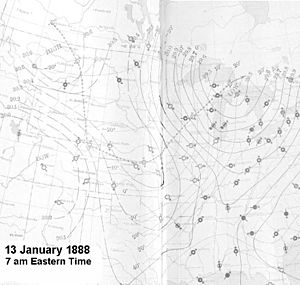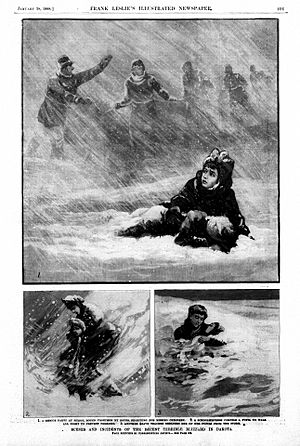Schoolhouse Blizzard facts for kids

Surface analysis of Blizzard on January 13, 1888.
|
|
| Type | Extratropical cyclone Blizzard Winter storm |
|---|---|
| Formed | January 12, 1888 |
| Dissipated | January 13, 1888 |
| Maximum snowfall or ice accretion | 6 inches (15 cm) |
| Areas affected | Mid-Western US |
The Schoolhouse Blizzard was a huge winter storm that hit the central plains states of the U.S. on January 12, 1888. It is also known as the Schoolchildren's Blizzard or Children's Blizzard. This blizzard came as a surprise on a day that felt quite warm. Many people were caught off guard, including children who were at school in small one-room schoolhouses.
Contents
What Caused the Schoolhouse Blizzard?
Before this big blizzard, there was a snowstorm from January 6 to January 11. This storm dropped snow across the northern and central plains. After that, very cold weather hit from January 7 to 11.
The official weather forecast for January 12 was from the Weather Bureau. It warned of a "cold wave" and "heavy snow drift" for areas like Dakota, Nebraska, Minnesota, and Wisconsin.
How the Storm Formed
On January 11, a strong low-pressure system moved from Alberta, Canada into Montana. By the morning of January 12, it was in northeastern Colorado. Before the storm hit, temperatures actually went up quite a bit. For example, in Omaha, Nebraska, it was −6 °F (−21 °C) on January 11, but it warmed to 28 °F (−2 °C) by January 12.
This strong low-pressure system moved quickly. It reached southeastern Nebraska by 3 p.m. on January 12. Later that night, it was in southwestern Wisconsin. A huge mass of cold air had formed around January 8 in Canada. This cold air spread out over 780 miles (1,255 km).
The blizzard happened when this giant Arctic cold front crashed into warm, moist air from the Gulf of Mexico. In just a few hours, the temperature dropped from above freezing to −20 degrees Fahrenheit (-29 degrees Celsius). Some places even saw temperatures of −40 °F (−40 °C). Along with this extreme cold came very strong winds and heavy snow.
The Storm's Fast Arrival
The fast-moving storm first hit Montana early on January 12. It then swept through Dakota Territory from mid-morning to early afternoon. By 3 p.m., it had reached Lincoln, Nebraska.
Many people were not ready for the storm because of the warm weather before it. Carl Saltee, a teenager in Minnesota, remembered that on January 12, it was warm enough to melt ice. But by 3:30 p.m., he saw a "dark and heavy wall" of storm clouds. He said it came "like a shot" and became the "severest snowstorm" he had ever seen. The snow was so thick you could barely see a few steps.
Why the Blizzard Was So Dangerous
The storm was deadly for several reasons:
- Timing: It hit during work and school hours.
- Suddenness: It came on very quickly.
- Warm Spell: The warm weather before tricked people into thinking it was safe to go outside.
- Zero Visibility: The incredibly strong winds and powdery snow made it impossible to see anything on the open plains.
Because of this, thousands of people, including many schoolchildren, were caught in the blizzard. Sadly, 235 people died. Teachers often kept children safe inside their schoolrooms. When they tried to leave, it often led to danger. Travel was also very difficult for days after the storm.
Two months later, another big blizzard hit the East Coast. That storm was called the Great Blizzard of 1888. It affected states like New York and Massachusetts.
Amazing Stories of the Blizzard
Many brave stories came from the Schoolhouse Blizzard. Here are a few:
- Plainview, Nebraska: Lois Royce was a teacher trapped with three students. They ran out of heating fuel. Her home was only 82 yards (75 m) away, so she tried to lead the children there. But the snow was so thick they got lost. The two nine-year-old boys and a six-year-old girl froze to death. Lois survived, but her feet were frostbitten and had to be amputated.
- Seward County, Nebraska: Etta Shattuck, a 19-year-old teacher, got lost on her way home. She found shelter in a haystack. She was stuck there for 78 hours until she was rescued. Sadly, she died later from problems with surgery to remove her frostbitten feet and legs.
- Mira Valley, Nebraska: Minnie Freeman was a teacher who safely led thirteen children from her schoolhouse to her home. It was one and a half miles (2.4 km) away. A popular story says she used a rope to keep the children together, but one of her students said this wasn't true. All of her students survived. A song called "Song of the Great Blizzard: Thirteen Were Saved" was written in her honor.
- In 1967, a special glass mural about Minnie Freeman and the blizzard was put in the Nebraska State Capitol building in Lincoln, Nebraska.
- Woodstock, Minnesota: James Jackson, a 36-year-old farmer, found his entire cattle herd frozen to death. They were spread out over 10-mile (16 km).
- Marion, South Dakota: William and Kate Kampen lived in a small sod house. They ran out of coal for their fire. William had to go to Parker, South Dakota, 23 miles (37 km) away, to buy more. While he was gone, 19-year-old Kate gave birth to their first son, Henry. The blizzard hit while William was in town. His friends tried to get him to stay, but he knew he had to get back to Kate. He tried to ride his horses home, but they both died from the strong winds. William found a barn with pigs and crawled in to stay warm. Kate kept herself and the baby warm by staying in bed. William finally made it home after three days and nights alone in the storm.
Remembering the Blizzard
In the 1940s, a group called the Greater Nebraska Blizzard Club was formed. They wanted to write a book about the storm. The book, called In All Its Fury: A History of the Blizzard of Jan. 12, 1888, With Stories and Reminiscences, shares many stories and memories from that day.
Areas Affected by the Blizzard
Many of these states were United States territories at the time:
- South Dakota (territory)
- North Dakota (territory)
- Nebraska
- Kansas
- Minnesota
- Montana (territory)
- Wyoming (territory)
- Idaho (territory)


